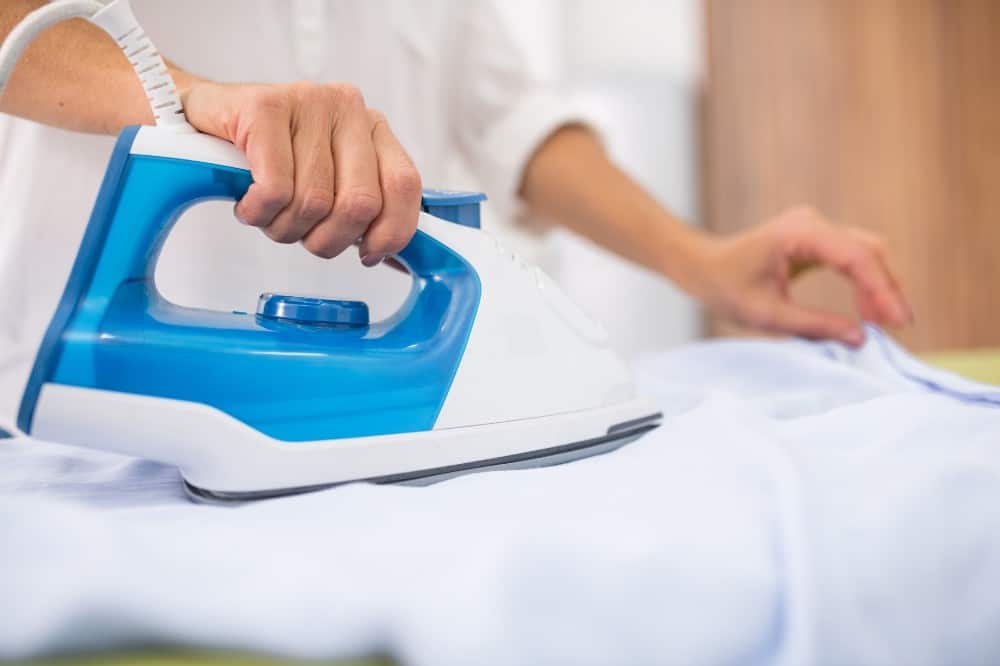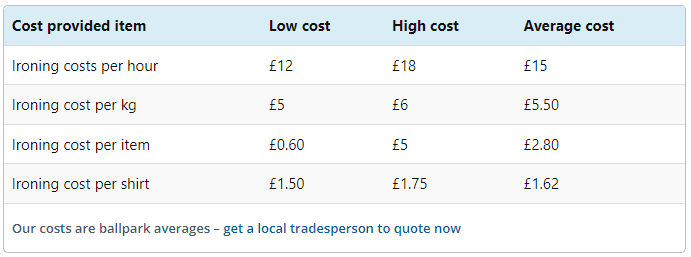If you’re looking for a flexible and profitable way to work from home, and you feel as if you don’t have any ‘skills’ as such, then starting an ironing business could be the answer.

In fact, some people find ironing therapeutic and a bit of a stress reliever; so if this is you, or you just enjoy ironing, then why not seriously consider starting up your own ironing business from home.
Offering an ironing service from home has several amazing advantages:
- You get to choose your own schedule.
- Work at your own pace.
- Offer services that are in high demand.
- Set your own pricing structure.
- It requires minimal start-up costs.
- It requires minimal overhead costs.
Therefore, making an at home ironing service is the perfect home-based business idea for anyone who likes to iron.
In this guide, I’ll will walk you through the steps you need to take to start your own home-based ironing business, including:
- Setting your prices
- Setting up your workspace
- Marketing your services, and
- Attracting customers.
Why Start an Ironing Business from Home?
By offering home business ironing services, you can provide a flexible and personalized service to your customers, which can lead to strong customer loyalty and repeat business.
Working from home also allows you to set your hours and rates, giving you control over how much you earn and how many customers you serve.
So it just goes to show how popular and in demand an ironing service actually is.
If you’re looking for a business that gives you the freedom to work from home and provides a valuable service to your clients, starting your own home-based ironing business may be the perfect fit for you.
Is an Ironing Business Profitable?
Because many people are so busy today and lead such hectic lifestyles, lots of people are looking to services such as ironing, house cleaning and garden tidy-up, to help relieve their workload.
Therefore, offering a professional ironing service capitalizes on this demand for convenience.
Additionally, specialized ironing services can cater to specific needs, such as delicate fabrics or intricate garments, further distinguishing themselves in the market.
With the potential for repeat business and positive word-of-mouth referrals, an ironing service can establish a steady client base, leading to a profitable venture in the service industry.
How Much Should You Charge for Ironing?
How much you can earn from ironing depends on what you charge and were you live.
Not all areas charge the same rates, as some areas are more affluent than others and therefore the prices for an ironing service will be higher than the lower-income local areas.
You also need to decide if you want to charge by:
- Per kg
- Per item
- Per hour, or
- Per shirt
Shirts are very common items in need of an ironing service, especially among office workers, executives and professionals. So you might want to factor in a separate price just for shirts.
Either way, you want to set your pricing which is the most profitable, but easiest solution for you.
Here’s an example of ballpark averages: Chart courtesy of CheckaTrade
Chart courtesy of CheckaTrade
The best research you can do to help you determine your own ironing service prices is to ring around all the local ironing services in your area and ask what they charge – you’ll have to pretend to be a potential customer making an enquiry.
Make a list of which ironing service you rang, what they charge and how they charge (i.e. per kg or per item) and then set your own pricing structure accordingly by what you feel comfortable with the most.
Also, once you get started and you feel that this pricing structure doesn’t work for you, then you can always change it in the future.
$2,000 Per Month Scenario:
$1.20 per item.
You can iron 20 items per hour.
$1.20 x 20 = $24 per hour.
20 hours of ironing per week @ £24/hr = $480
$480 x 4 = $1,920 Per Month
Six Steps to Starting an Ironing Business
We’ve covered the most important step, your pricing structure, so now let’s take a look at the other necessary steps you need to take to get your ironing service up and running.

| Step | Description |
|---|---|
| 1 | Research the market: Identify other local ironing services. Evaluate their pricing structures and customer bases. Research any potential opportunities to differentiate your business from competitors. |
| 2 | Get necessary equipment: You’ll need an iron, an ironing board, hangers, and plastic bags. Depending on the scale of your operation, consider purchasing a steam press or a commercial iron. |
| 3 | Determine your pricing strategy: Set competitive prices based on your market research while considering your time and expenses. |
| 4 | Permits, Licenses & Insurance: Check to see is you need a special permit to run an ironing business from home, and make sure you’re covered for any accidents and damages. |
| 5 | Market your business: Create promotional materials such as flyers or business cards. Utilize social media platforms to connect with potential customers, share photos, and offer promotions. Network with other local businesses. |
| 6 | Build a network of satisfied customers: Provide professional and reliable service. Encourage satisfied customers to leave reviews and refer others to your business. |
So let’s quickly go through each of these six steps.
1. Research The Market
You need to research your competitors and see who their target customers are.
Look for gaps in their service and see if you can fill in those gaps so you can get the edge over your competitors.
For example, do they ask customers to drop off and pick up their ironing? If so, would you want to offer a delivery service to drop off ironed garments at your customers’ homes?
Of course, you’ll have to charge extra for this service, but it might be something that your competitors aren’t doing; and that many customers wouldn’t hesitate to pay a little bit extra for.
2. Setting Up Your Home Ironing Space
Your next step is to think about where you’re going to do your ironing and what equipment you’ll need to purchase.
Equipment Needed
When setting up your home-based ironing business, you’ll need to invest in quality equipment.
The good news is that starting an ironing services doesn’t require a lot of equipment, and therefore because of this, try and buy the best quality you can afford.
Here are the essentials which you’ll need:
| Equipment | What to Look for |
|---|---|
| Ironing board | Sturdiness, adjustable height, and width to accommodate various garments |
| Steam iron | Variable temperature settings, steam output, and ease of use |
| Hangers and garment bags | Durability, availability in different sizes, and suitability for various fabrics |
| Stain removers and detergents | Suitability for different fabric types, effectiveness, and low cost |
Workspace Organization
Next, you’ll need a dedicated and efficient workspace so you can be as productive as possible.
I do however appreciate that you may not have a designated room just to devote to ironing – not many people do! So let’s go through this little checklist and see what you need for an ironing business and how you can adapt these recommendations to best suit your living space:
- Choose a well-lit and well-ventilated room for your workspace.
- Ensure you have convenient access to electrics, water, and washroom facilities.
- Organize your space so everything you need is easily accessible.
- Create a designated area for ironing and another for storing your equipment and supplies.
- Ensure the workspace is child and pet-free to maintain safety and preserve your equipment.
Pets
Do you have pets which shed fur and produce an odour?
You definitely don’t want to do your ironing where fur and hair can come into contact with your client’s clothing.
Also, some pets do give off an odour, so you’ll not want to keep clothes in a room where the odour can transfer onto the clothing garments.
This is why you should ideally have a room where it is pet free – fur, hair and odour free.
3. Pricing Structure
We’ve already discussed how to set your pricing structure, but make sure you do your research and that you’re happy with the prices you’re going to charge, and that they are a good fit for your area and the type of customers you want to target.
For example, if you’re going to target busy male professionals who want their suit shirts ironed, then you can charge them slightly more than you would charge a busy, working mom of five kids.
4. Special Licence, Permits & Insurance
One of the key aspects of starting any business is obtaining the necessary permits, licenses and insurance.
To legally operate an ironing business, you may need to obtain a special license or permit, depending on the regulations in your area. These requirements can vary from one location to another, so it’s crucial to do your research and find out what you need to comply with.
Contact your local government offices or check their websites for specific information. This will ensure that you’re operating within the legal boundaries and avoid potential fines or penalties.
Additionally, it’s essential to have the right insurance coverage for your ironing business. Accidents can happen, and having the right insurance will protect both you and your clients.
General liability insurance is a common option for small businesses and will provide coverage for any damages or injuries that may occur while providing your services.
It’s also important to consider insurance for your equipment, such as irons and ironing boards, as they are essential tools of your trade.
So to reiterate, look into:
- Special licence
- Permit
- Accidental insurance for yourself and customers
- Damage Insurance for your equipment
5. Marketing and Growing Your Ironing Business
Once you have your equipment and designated area set up, it’s time to start thinking about how you’re going to market your new ironing business and get your first few customers.
Here are some marketing strategies to promote your ironing service:
Online Marketing Techniques
Creating a website that showcases your ironing service is a great way to attract customers. It can be a simple website that includes pricing, contact information, and photos.
Utilizing social media platforms like Facebook, Twitter, and Instagram can also help grow your reach. Make sure to post engaging content that showcases your ironing services.
Facebook Business Page
Facebook is a great platform to use for local marketing, which is what you’re after. You can set up a free Facebook business page and post daily on what you’re up to in your ironing business.
Lots of local service-based businesses use a free Facebook page instead of going down the website route; which could be costly and will force a new learning curve on you to keep the website updated.
Offline Marketing Techniques
Then of course, there’s offline marketing which you can do to let your target customers know about your ironing business.
Here are three effective ideas:
#1 Attending local events and setting up a booth can be a great way to reach out to your community and promote your ironing service.
#2 You can also distribute flyers at local laundromats or residential areas.
#3 Networking with relevant local businesses that could benefit from using an ironing service can also lead to future business opportunities.
| Offline Marketing Strategy | Pros | Cons |
|---|---|---|
| Attending Local Events | Opportunity to engage with the community and gain brand recognition | May require time and resources to set up |
| Flyer Distribution | Reach extensive customer base inexpensively | May be difficult to stand out and get flyers into the right hands |
| Networking with Local Businesses | Can lead to future business opportunities and referrals | May require time and resources to establish business relationships |
Remember, offline marketing is about getting your name out there in the local community. Be creative and consider unique approaches that align with your brand.
By leveraging both online and offline marketing techniques, you can attract new customers to your ironing service and grow your business over time.
6. Build a Portfolio of Clients
Once you start getting your first few ironing clients, you’ll want to turn them into regular clients. As briefly mentioned above, regular paying clients will give you a much more stable business and income cash-flow.
So give a quality service by impressing your clients with not only impeccable ironed clothing, but also a warm, friendly and welcoming customer service.
You can then use these happy customers as testimonies and case studies to help you promote your ironing service and fill your weekly diary with clients who rely on you and your amazing service to do their ironing for them.
Conclusion
By following the steps outlined in this guide, you can create a successful and profitable home-based ironing business that also caters to your local community’s needs.
Remember to remain organized, promote your services through various marketing channels, and consistently provide quality service to build a loyal customer base.
Starting an ironing business from home requires dedication, hard work, and patience, but the potential rewards are worth the effort.
With low start-up costs and the flexibility of being your own boss, you can enjoy a fulfilling career while achieving a work-life balance that suits your lifestyle.
Good luck!
Hi, I’m Claire Bullerwell
I’ve ran dozens of home-based businesses, both offline and online, since my early twenties. I started this blog to share all my wealth of knowledge and experience to help women just like you; to find your dream home business and to live your best life.
Follow me and let’s get acquainted…


